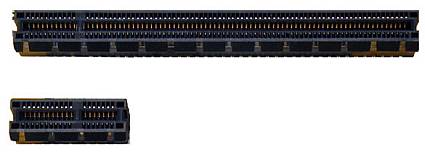PCI Express Battles PCI-X
The Challenge From PCI Express
These are x16 and x1 PCI Express slots.
Obviously, bandwidth cannot be a serious reason for moving from PCI-X to PCI Express in the professional market, because PCI-X has plenty. Thus, there must be other reasons to attract professional customers. Let's start by taking a look at current PCI Express speeds.
| PCI Express Modes ("Lanes") | Bandwidth | Connection Clock speed |
|---|---|---|
| x1 | 250 MB/s up and down | 100 MHz |
| x2 | 500 MB/s up and down | 100 MHz |
| x4 | 1 GB/s up and down | 100 MHz |
| x8 | 2 GB/s up and down | 100 MHz |
| x16 | 4 GB/s up and down | 100 MHz |
As you can see in the image at the top of this page, PCI Express x1, which is the simplest configuration, requires very few connectors and still achieves a bandwidth that exceeds the capabilities of 33 MHz 32 Bit PCI by at least a factor of two. The reason for this is its serial operation - rather than transferring one bit per pin as is the case with PCI(-X), PCI Express uses two low-voltage differential signaling pairs that run at 2.5 Gbit/s each. PCIe uses an encoding method that takes 10 bits of signal for every 8 bits of data, which explains why 2.5 Gbit/s per lane results in 250 MB/s rather than 312.5 MB/s (as it would be with 8 bit transferred per 8 bits signaled). Obviously the low pin count can be an advantage for motherboard designs, since routing becomes easier.
Get Tom's Hardware's best news and in-depth reviews, straight to your inbox.
Current page: The Challenge From PCI Express
Prev Page PCI-X Modes Compared Next Page HighPoint's RocketRAID 2320 PCIe Controller
Patrick Schmid was the editor-in-chief for Tom's Hardware from 2005 to 2006. He wrote numerous articles on a wide range of hardware topics, including storage, CPUs, and system builds.
-
herb2021 Buyers need to be very aware of limited compatiblility with many of today's MB. Will not work in many machines. Highpoint Tech support is one of the worst I have worked with. No indication of any technical ability in those I have worked with.Reply
